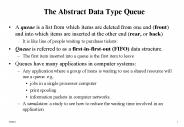Externalizing Abstract Mathematical Models
1 / 14
Title:
Externalizing Abstract Mathematical Models
Description:
Imperial College Of Science,Technology and Medicine. London,UK. ... Optimize the Performance values by specifying the tolerance range of the Parameter variables. ... –
Number of Views:41
Avg rating:3.0/5.0
Title: Externalizing Abstract Mathematical Models
1
Externalizing Abstract Mathematical
Models
- Lisa Tweedie,Robert Spence, Huw Dawkes and Hua
Su - Department of Electrical Engineering,
- Imperial College Of Science,Technology and
Medicine - London,UK.
- Conference proceedings on Human factors in
computing systems, -
1996, Page 406
2
Data
- Interactive Visualization ArtifactsIVAs
- -Environments for problem solving
- Visualization of precalculated or generated data
from abstract mathematical models. - Not Raw Data
3
- Application Domain
- - Engineering Design
- Mantra
- - Multiple ways of interactively
linking simple graphs
4
Mission
- Parameters, Performances
Optimize the Performance values by specifying the
tolerance range of the Parameter variables.
Overall Design Objective
5
The Influence Explorer
- Population of 600 precalculated light bulb
designs - Performances -- Horizontal Histograms to the
Left - Parameters -- Vertical Histograms to the
Right
6
The Prosection MatrixProjection of a section of
parameter space
- Alternative Perspective of the same precalculated
data - Scatter plots arranged in a matrix
- Each scatter plot corresponds to a pair of
- possible parameter combination
- All combinations 4C2 of 4 parameters
- represented
7
Projection of a section of parameter space
8
Visualization when the parameters are set
9
High yield and Wider tolerances
10
Formative evaluation
- Number of tests at different development stages
- Ten pairs of participants
- Tested first with Influence Explorer then with
Prosection Matrix and then with Both - Each pair could complete a tolerance task in 30
min
11
Lessons
- Maximize directness of interactivity
- Seek crucial information and give it a
- simple and pertinent representation
- Trade off between amount of information,
- accuracy and simplicity
12
Merits
- Initial Qualitative Understanding
- Performance Trade offs known with lesser effort
- Quantitative Detail becomes clear by the color
coding. - Parameter tolerance ranges defined with ease
13
Demerits
- Specific Requirements are hard to be visualized
by color coded points - Hard to use without proper training
- Designers experience is not enhanced
14
HCI Metrics
- User Performance
- Error recovery
- User satisfaction ?
- Learning Time
- Retention































